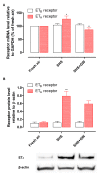Secondhand smoke exposure induces Raf/ERK/MAPK-mediated upregulation of cerebrovascular endothelin ETA receptors
- PMID: 22044770
- PMCID: PMC3219602
- DOI: 10.1186/1471-2202-12-109
Secondhand smoke exposure induces Raf/ERK/MAPK-mediated upregulation of cerebrovascular endothelin ETA receptors
Abstract
Background: Cigarette smoking enhances the risk of stroke. However, the underlying molecular mechanisms are largely unknown. The present study established an in vivo rat secondhand cigarette smoking (SHS) model and examined the hypothesis that SHS upregulates endothelin receptors with increased cerebrovascular contraction via the Raf/extracellular signal-regulated kinase (ERK)/mitogen-activated protein kinases (MAPK) pathway.
Results: Rats were exposed to SHS for up to 8 weeks. The cerebral artery vasoconstriction was recorded by a sensitive myograph. The mRNA and protein expressions for endothelin receptors in cerebral arteries were studied by real-time PCR and Western blot. Compared to fresh air exposed rats, cerebral arteries from SHS rats exhibited stronger contractile responses (P < 0.05) mediated by endothelin type A (ETA) receptors. The expressions of mRNA and protein for ETA receptors in the cerebral arteries from SHS rats were higher (P < 0.05) than that in control. SHS did not affect endothelin type B (ETB) receptor-mediated contractions, mRNA or protein levels. The results suggest that SHS upregulates ETA, but not ETB receptors in vivo. After SHS exposure, the mRNA levels of Raf-1 and ERK1/2, the protein expression of phosphorylated (p)-Raf-1 and p-ERK1/2 were increased (P < 0.05). Raf-1 inhibitor, GW5074 suppressed the enhanced ETA receptor-mediated contraction, mRNA and protein levels induced by SHS. In addition, GW5074 inhibited the SHS-caused increased mRNA and phosphorylated protein levels of Raf-1 and ERK1/2, suggesting that SHS induces activation of the Raf/ERK/MAPK pathway.
Conclusions: SHS upregulates cerebrovascular ETA receptors via the Raf/ERK/MAPK pathway, which provides novel understanding of mechanisms involved in SHS-associated stroke.
Figures



Similar articles
-
Secondhand smoke exposure causes bronchial hyperreactivity via transcriptionally upregulated endothelin and 5-hydroxytryptamine 2A receptors.PLoS One. 2012;7(8):e44170. doi: 10.1371/journal.pone.0044170. Epub 2012 Aug 27. PLoS One. 2012. PMID: 22952915 Free PMC article.
-
Secondhand cigarette smoke exposure causes upregulation of cerebrovascular 5-HT(1) (B) receptors via the Raf/ERK/MAPK pathway in rats.Acta Physiol (Oxf). 2013 Jan;207(1):183-93. doi: 10.1111/j.1748-1716.2012.02478.x. Epub 2012 Sep 4. Acta Physiol (Oxf). 2013. PMID: 22883081
-
Cigarette smoke upregulates rat coronary artery endothelin receptors in vivo.PLoS One. 2012;7(3):e33008. doi: 10.1371/journal.pone.0033008. Epub 2012 Mar 7. PLoS One. 2012. PMID: 22412974 Free PMC article.
-
Targeting the Raf-MEK-ERK mitogen-activated protein kinase cascade for the treatment of cancer.Oncogene. 2007 May 14;26(22):3291-310. doi: 10.1038/sj.onc.1210422. Oncogene. 2007. PMID: 17496923 Review.
-
Roles of the Ras/Raf/MEK/ERK pathway in leukemia therapy.Leukemia. 2011 Jul;25(7):1080-94. doi: 10.1038/leu.2011.66. Epub 2011 Apr 15. Leukemia. 2011. PMID: 21494257 Review.
Cited by
-
Evaluation of Foveal Avascular Zone and Capillary Plexus in Smokers Using Optical Coherence Tomography Angiography.J Curr Ophthalmol. 2020 Mar 23;32(1):53-57. doi: 10.1016/j.joco.2019.09.002. eCollection 2020 Jan-Mar. J Curr Ophthalmol. 2020. PMID: 32510014 Free PMC article.
-
Secondhand smoke exposure causes bronchial hyperreactivity via transcriptionally upregulated endothelin and 5-hydroxytryptamine 2A receptors.PLoS One. 2012;7(8):e44170. doi: 10.1371/journal.pone.0044170. Epub 2012 Aug 27. PLoS One. 2012. PMID: 22952915 Free PMC article.
-
Flavonol-rich dark cocoa significantly decreases plasma endothelin-1 and improves cognition in urban children.Front Pharmacol. 2013 Aug 22;4:104. doi: 10.3389/fphar.2013.00104. eCollection 2013. Front Pharmacol. 2013. PMID: 23986703 Free PMC article.
-
Effect of Shenkang granules on the progression of chronic renal failure in 5/6 nephrectomized rats.Exp Ther Med. 2015 Jun;9(6):2034-2042. doi: 10.3892/etm.2015.2383. Epub 2015 Mar 24. Exp Ther Med. 2015. PMID: 26136932 Free PMC article.
-
Up-regulation of contractile endothelin receptors by airborne fine particulate matter in rat mesenteric arteries via activation of MAPK pathway.Environ Sci Pollut Res Int. 2018 May;25(15):14713-14725. doi: 10.1007/s11356-018-1694-y. Epub 2018 Mar 13. Environ Sci Pollut Res Int. 2018. PMID: 29536419
References
-
- Mazzone P, Tierney W, Hossain M, Puvenna V, Janigro D, Cucullo L. Pathophysiological impact of cigarette smoke exposure on the cerebrovascular system with a focus on the blood-brain barrier: expanding the awareness of smoking toxicity in an underappreciated area. Int J Environ Res Public Health. 2010;7:4111–4126. doi: 10.3390/ijerph7124111. - DOI - PMC - PubMed
Publication types
MeSH terms
Substances
LinkOut - more resources
Full Text Sources
Medical
Research Materials
Miscellaneous

